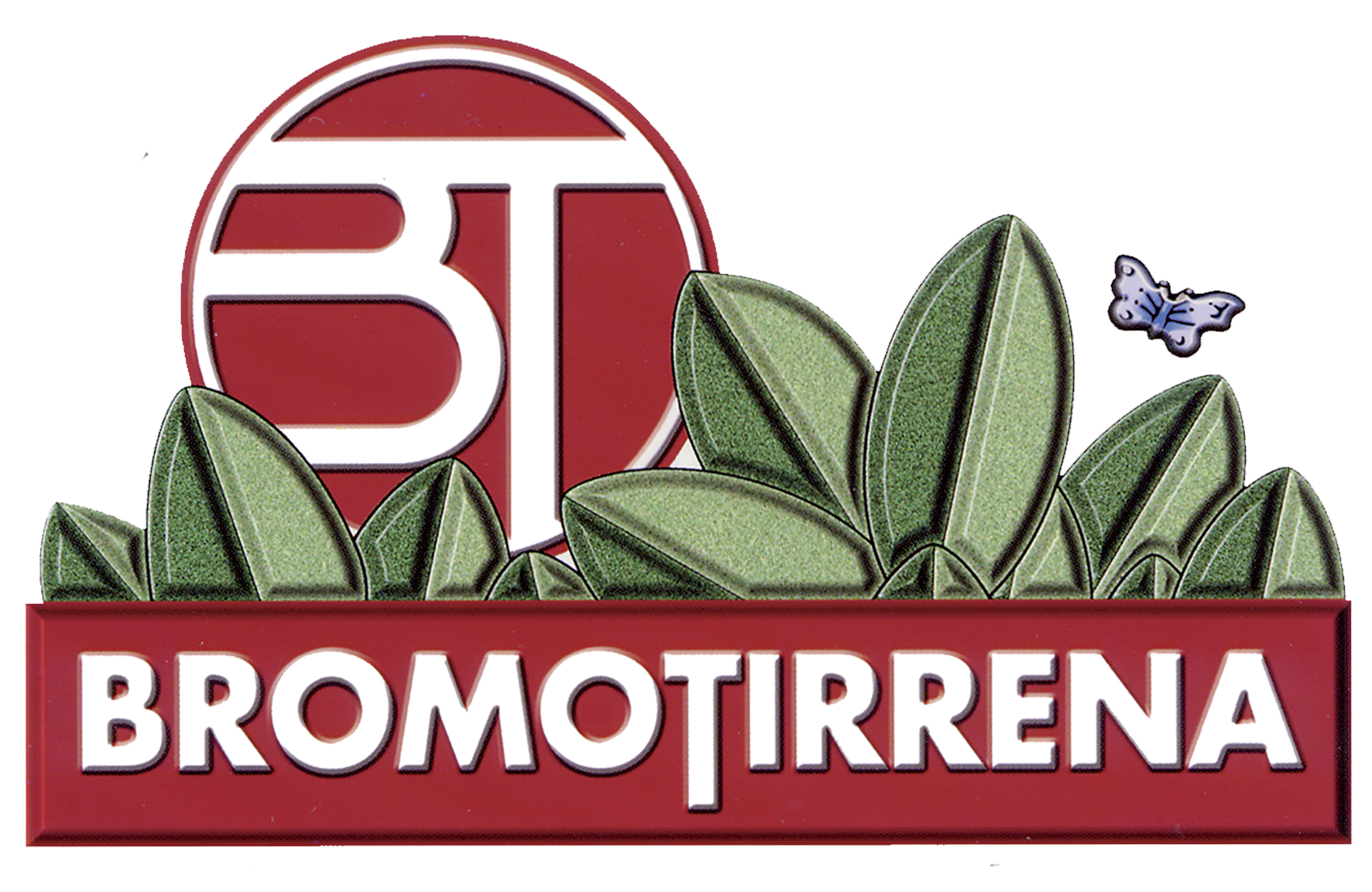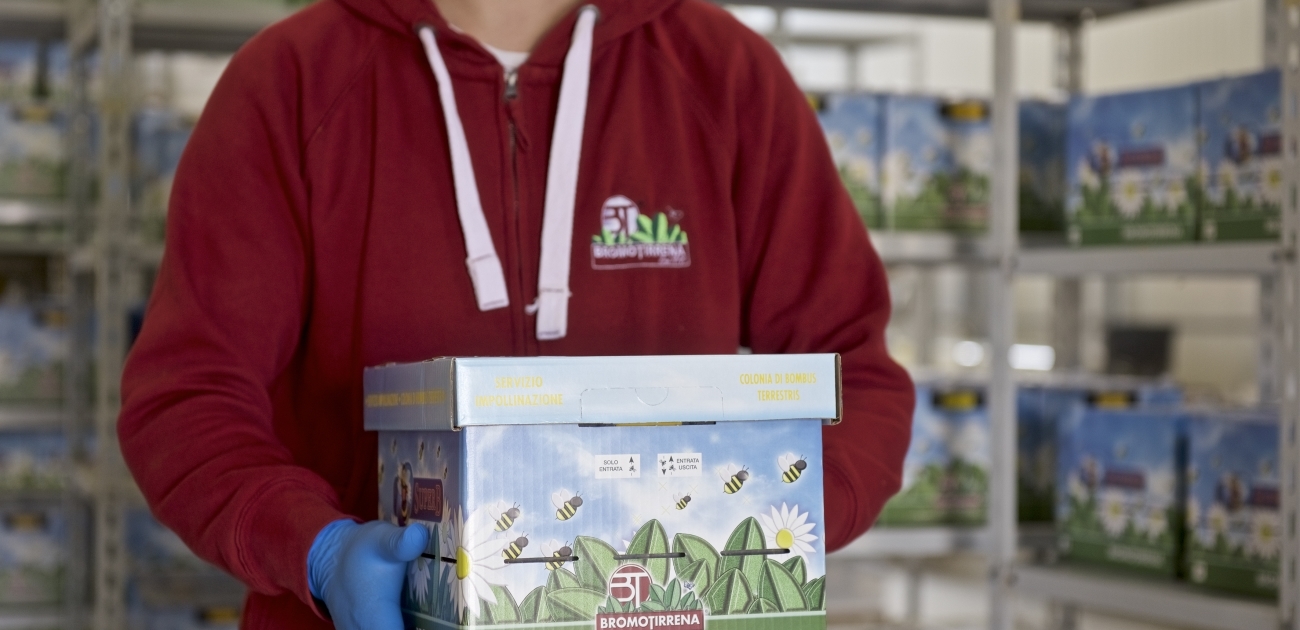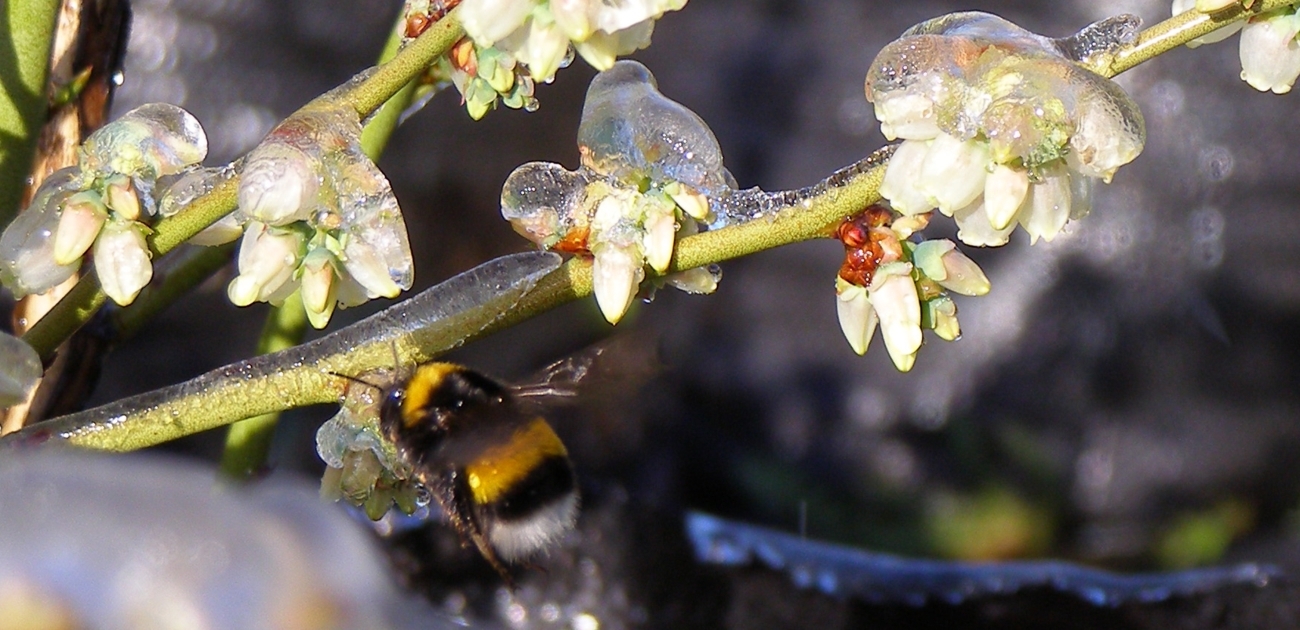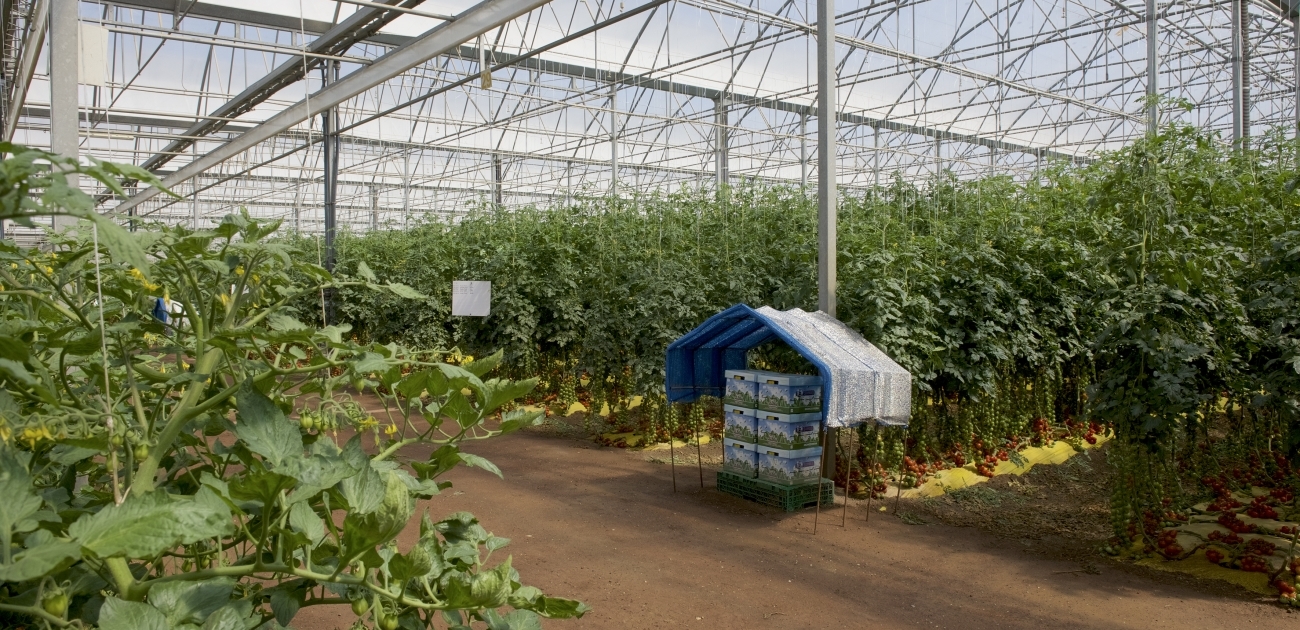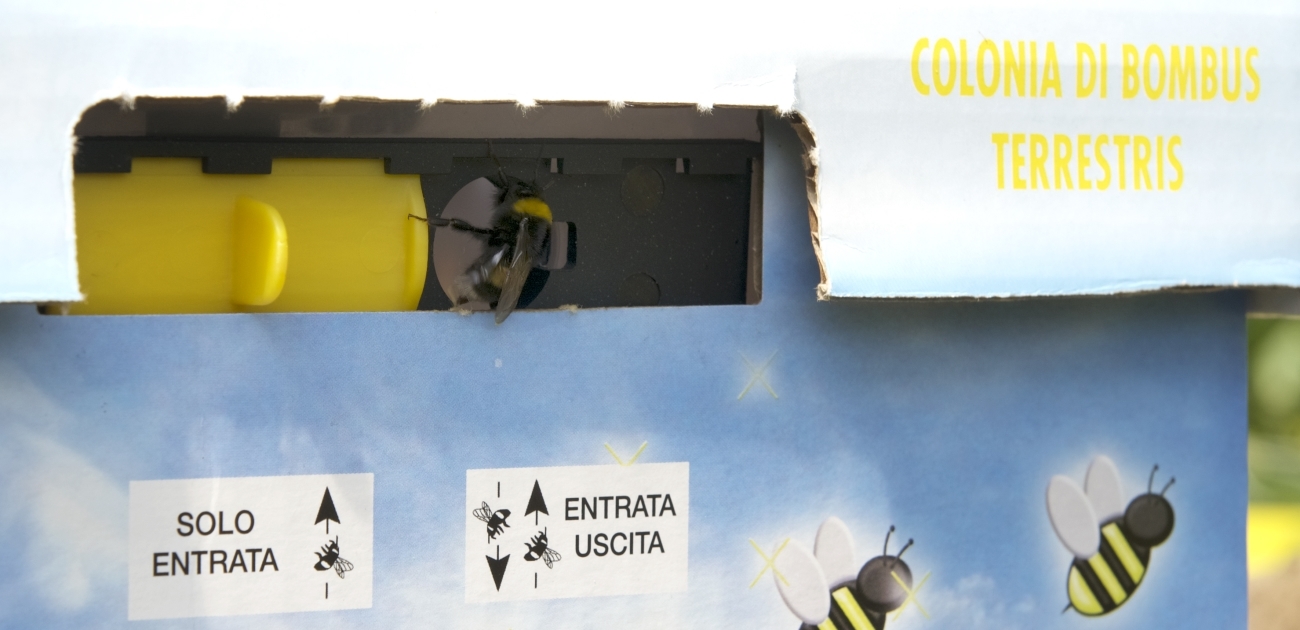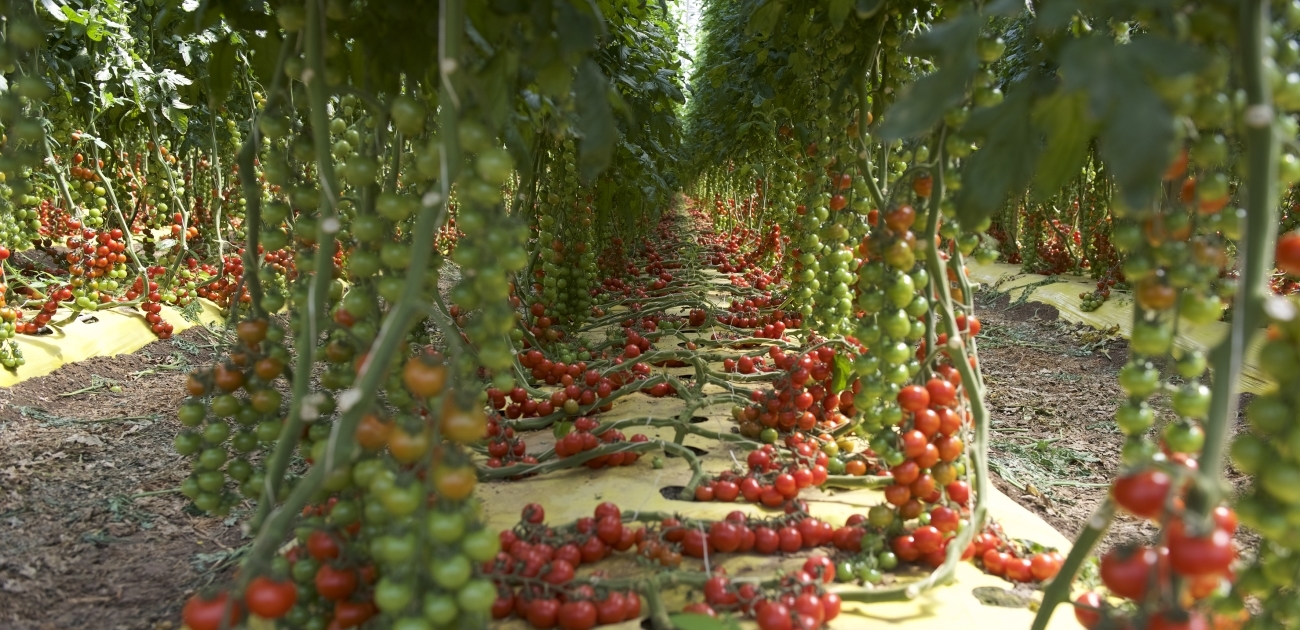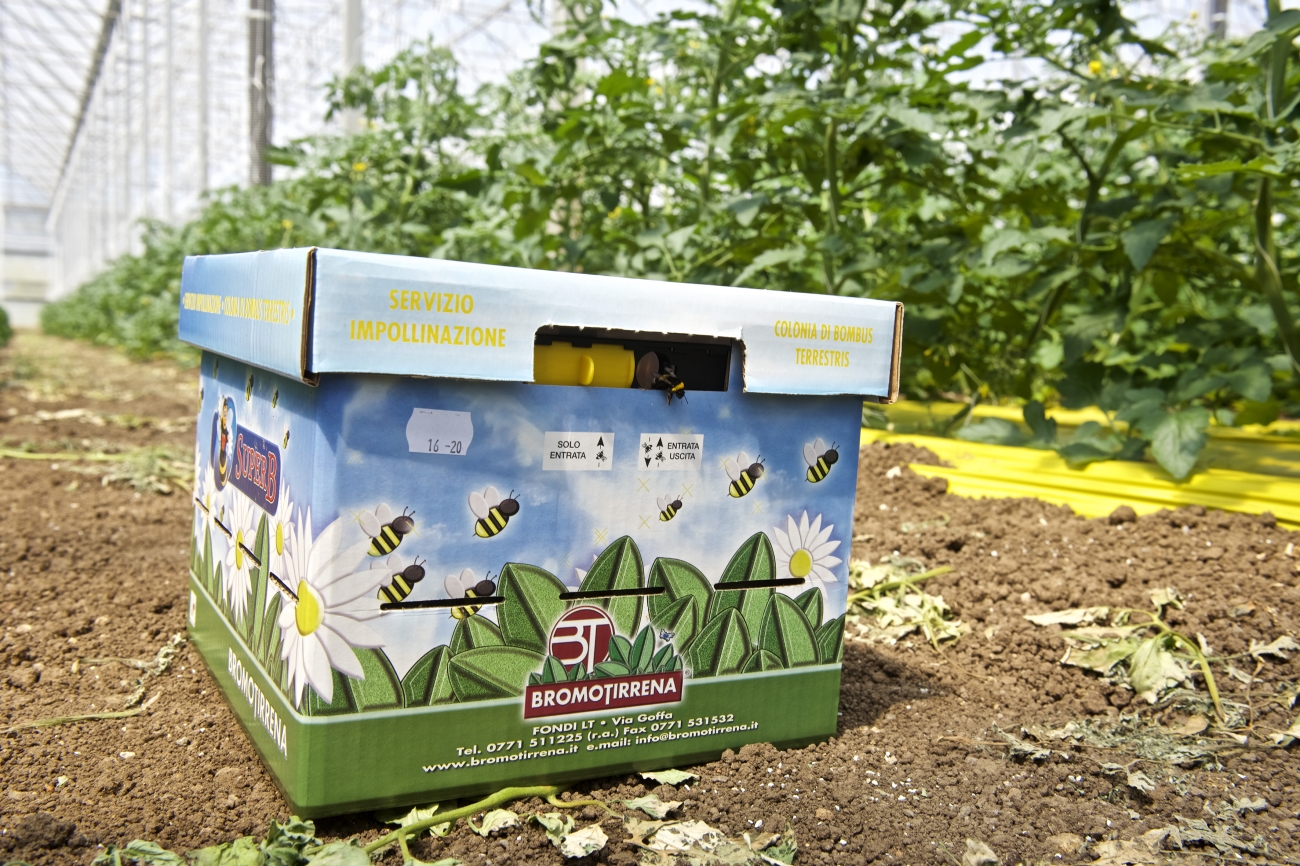Bromotirrena believes in the values of organic farming and promotes production systems that utilise the intrinsic fertility of the soil and the use of beneficial insects, thus reducing the environmental damage caused by the use of fertilisers, pesticides and synthetic chemical medicines.
For years, the company has been working alongside Italian farmers, who choose to exploit the benefits of natural pollination with bumblebees to increase crop yields and quality.
ADVANTAGES OF POLLINATION WITH BUMBLEBEES
Bumblebees are social insects belonging to the entomological order Hymenoptera, found in nature in a large number of species with different biological characteristics. They are organised in colonies, each with a queen who lays eggs and many workers who collect pollen and nectar for themselves and their larvae.
At the end of the 1980s, Bombus terrestris, with its more than three hundred species worldwide, was the subject of important scientific studies that demonstrated the extraordinary effectiveness and reliability of these insects for the natural pollination of certain crops especially tomatoes; the use of pollinating bumblebees is absolutely strategic for both protected crops (tomato, pepper, aubergine, courgette, strawberry, melon) and field crops (kiwi, avocado, apricot, plum).
The introduction of artificial hives of bumblebees in protected crops of tomatoes dates back to 1988-89; since then, the technique has been refined a great deal, with facets that relate to the various types of tomatoes grown and the different types of crop cycle.
Why tomatoes?
The producers of tomatoes are faced with a problem that is not easy to solve. The tomato flower has physiological and morphological characteristics that make it difficult to pollinate for protected crop production: it does not produce nectar and, even if pollen is produced in large quantities, it has no particular nutritional qualities for pollinating insects, nor is it easy to extract and use due to the shape of the flower.
At this point, growers may consider two different paths to take:
• carry out ventilation to ensure the bud setting of the new flowers produced by the tomato;
• placing artificial hives of bumblebees, bred in bio factories, in greenhouses.
The latter is often the best solution. The bumblebees, by attaching themselves to the flower, produce a kind of vibration (buzz pollination), which results in an abundant release of pollen, part of which is collected by the insect and part of which goes to pollinate the flower. The visited flower shows characteristic marks and is called a “marked flower”: it is the first indication of the bumblebees’ work. This practice is now consolidated in almost all horticultural areas of Europe, Asia and North Africa. In Italy, where tomatoes are cultivated with very different techniques and the same varieties have a high variability with respect to fundamental characteristics such as the aptitude to produce pollen or preferences for humidity and temperature, pollination with bumblebees has taken on a strategic role, developing in-depth knowledge of the different operating contexts and ad hoc intervention methods.
HOW DOES POLLINATION WITH BUMBLEBEES WORK IN TOMATO GREENHOUSES?
Cultivation cycles can be very varied. In recent years, the traditional short spring-summer cycle has been flanked by others with different durations and times; the development of long cycle outdoor cultivation, from January to November, has also opened up new perspectives. The lengthening of cycles makes the use of bumblebees practically indispensable.
How to calculate the number of hives needed
The cubage and surface area of the greenhouse are fundamental elements, together with the type of tomato cultivated, in defining the quantity of pollen produced. For example, a 500 m2 cherry tomato greenhouse in optimal conditions can guarantee a quantity of pollen comparable to that produced by an area twice the size of other varieties and sufficient for the needs of one hive without incurring problems of colony stress.
In common practice and in the presence of sufficient pollen, an area of 1000-1500 m2 of greenhouse is indicated as a typical unit on which to place a hive, without problems of efficiency and duration of the colony.
Correct positioning of the hive
The beehive must be placed carefully, avoiding excessive exposure to the sun; it must be positioned approximately 50 cm from the ground and in a position that ensures proper shading and minimal climatic variations.
The introduction of beehives must be regular and constant
The first form of evaluation of bumblebee activity is flower marking. Experience has shown that, if optimal levels of marking are to be maintained over the long term, the introduction of hives must be regular and constant. The bumblebee colonies, in fact, once they reach a peak of activity, reduce their action after about 4-6 weeks, with a consequent drop in the level of flower marking. Considering, then, that a beehive is capable of covering 1000-1500 m2 of greenhouse with its activity, depending on the type of tomato and thus on the greater or lesser presence of flowers, 2-3 beehives per hectare per week should be introduced regularly. The bumblebees are thus obliged to work on the newly formed flowers, causing a kind of early fruit setting with positive results especially on the vine tomatoes and datterino varieties.
The well-being of the colony must always be favoured
Bumblebee activity always takes place in the interest of the social organisation of the nest. The farmer must control and keep favourable the factors that affect the quality of life inside the nest, as the well-being of the colony undoubtedly affects the activity outside. The temperature and humidity inside the hive, for example, can be regulated by the bumblebees, but this requires time and effort: if the workers are busy ‘ventilating’ to lower the humidity or, on the contrary, producing heat to raise the temperature, they cannot go out in search of food and in fact neglect foraging activity.
Pollen availability and quality are key success factors
Pollen is the indispensable protein source for feeding the bumblebee larvae inside the hive. The growing environment must provide the plants with optimal conditions for development, so that they produce fresh pollen in large quantities. A temperature of 6-7 °C for four or five consecutive nights is capable of blocking pollen production, just as temperatures above 35 °C in midsummer predispose flowers to the longistilisation phenomenon. Under conditions of pollen deficiency, the bumblebee colony drastically reduces its activity; on the contrary, if the pollen is ‘good’, the bumblebee feeds and develops progeny, while the tomato produces berries to its full potential.
No to the indiscriminate use of pesticides and chemicals
The phytoiatric management of the tomato must be such that it does not interfere with the life of the bumblebees, using only active substances compatible with their activity. In fact, one must always bear in mind that any treatment can have repercussions on all living organisms present, bumblebees included. Many chemical agents do not have a direct toxic effect, but can lead to indirect phenomena such as disorientation of adults or intoxication of the brood caused by contaminated pollen. In both cases, the damage is serious and can have a devastating effect on the nest causing the cessation of all activity.
The choice of techniques to be applied must therefore go in the direction of maximum respect, with preference being given to biological defence techniques.
Other measures
The tomato flower has characteristics that are not particularly appreciated by pollinators and even the bumblebee, if put in a position to choose, may prefer the flowering of other flowers. It follows that the use of nets becomes essential to optimise the hive’s work on the crop, limiting possible distractions.
OUR HIVES
Super B bumblebees
Since 2001 we have been producing and marketing a type of hive patented by Bromotirrena, called Super B.
- The natural life cycle of the bumblebees is entirely reproduced within our plant, in Fondi (LT), and the excellent performance is guaranteed by a strict and restrictive selection carried out during all breeding phases.
- We ensure maximum product availability and very short delivery times.
- Each hive contains a queen, approximately 150-200 forager workers and an adequate number of eggs, larvae and pupae.
- The duration is approximately 5-7 weeks.
- The number of hives to be used depends on the variety of crops and the size of greenhouses or fields.
- The bumblebee hive should be placed in the coolest and most ventilated area, using shading systems to avoid direct light irradiation.
- Bumblebees are very sensitive to pesticides, which adversely affect them even if used long before they are introduced. If it is necessary to carry out phytosanitary treatments, the hive should be removed.
- Our technicians offer specific training to farmers in the set-up and maintenance of hives and are always available for after-sales service.
